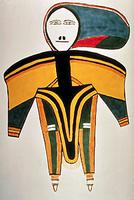
Jessie Oonark, "Una," OC, artist (born 1906 in the Back River area, NWT [now Nunavut]; died 2 March 1985 in Churchill, MB). Jessie Oonark was elected to the Royal Canadian Academy of Arts in 1975, and was awarded the Order of Canada in 1984. In 1987 the Art Gallery of Ontario presented a major retrospective of her work and her largest work, Untitled (1973) (a wool and felt piece, four by six metres) has hung intermittently ever since in the foyer of the National Arts Centre in Ottawa.
Life on the Land and Transition to Baker Lake
Jessie Oonark’s family were members of the Utkusiksalingmiut people, a semi-nomadic people who lived a traditional life dependant on fishing and caribou hunting. Utkusiksalingmiut means “the people of the soapstone pots.” Oonark was influenced by her father Helaquarq who is said to have been a shaman. She was named after her paternal grandfather and throughout her life she was called “Una.” Oonark had a largely traditional upbringing, learning many skills such as the processing of caribou and seal skins, and how to sew clothing and parkas out of these materials. Declines in the caribou population and the global demand for Arctic fox furs in the late 1950s culminated in her people settling in Baker Lake. Oonark “Una” herself was married at the age of 12 and had 13 children, eight of whom survived to maturity. She was widowed and settled in Baker Lake in 1958 with her surviving children. Initially she supported herself by working as a janitor, until a biologist working in Baker Lake, Dr. Andrew Macpherson, recognized her artistic talent and gave her first set of drawing materials. Oonark’s talent was recognized by an art advisor at Baker Lake and she was given a private studio and a small salary to allow her to work full time. Oonark was a major force in the development of the graphic arts program at Baker Lake in the 1960s and 1970s. Between 1970 and 1985 more than 100 of Oonark’s drawings were translated into prints and issued in the annual Baker Lake print editions.
A Vision Inspired by a Traditional Life
Jessie Oonark is known for her drawings and wall hangings, and her decorative, hieratic, brilliantly coloured images come from a lifetime of cutting caribou skins and sewing them into clothing. She created a unique personal vision by combining traditional Inuit images featuring the shaman’s flight with hunting scenes, and symbols from her experience as a devout Christian. Her work is characterized by flat planes of colour, the constant presence of a female figure, and in her large-scale tapestries of the 1970s and 1980s, the representation of several narratives in one work. In Untitled (1973) (a wool and felt piece, four by six metres), several traditional hunting scenes unfold while a female figure clad in white, representative of the figure of a shaman or angel, rises above the other narratives of the tapestry. Oonark’s career ended in 1979 when a medical condition caused her to lose feeling in her hands.
Jessie Oonark was the first artist who is not from Cape Dorset to be featured as a Cape Dorset artist. The Canadian Museum of History (then the National Museum of Man), featured her in a two-person exhibit in 1970. Queen Elizabeth was presented with a wall hanging by Oonark in 1973, and in 1975 Oonark was elected a member of the Royal Canadian Academy of Arts. In 1984 she was named Officer of the Order of Canada and in 1987 the Art Gallery of Ontario presented a major retrospective of her work.

 Share on Facebook
Share on Facebook Share on X
Share on X Share by Email
Share by Email Share on Google Classroom
Share on Google Classroom

